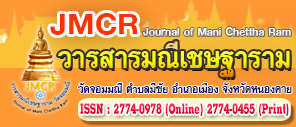THE ADMINISTRATION OF LEADING BUDDHIST SCHOOLS ACCORDING TO THE IDDHIPADA 4 OF SCHOOL ADMINISTRATORS UNDER THE SECONDARY EDUCATIONAL SERVICE AREA OFFICE LOEI NONGBUALAMPHU
Keywords:
The Administration of Leading Buddhist Schools According, The Iddhipada 4Abstract
Education management in Thailand It is the duty of the state according to the provisions of the Constitution of the Kingdom of Thailand B.E. Ethical and cultural in living can live with others happily
The objectives of this research were: 1) to study the administrative condition of leading Buddhist-oriented schools of educational institution administrators; 2) to study the administration of leading Buddhist-oriented schools according to the Four Iddhipada of educational institution administrators; 3) to study the guideline of the administration of leading Buddhist oriented schools according to the Four Iddhipada of educational institution administrators under the Office of Loei Secondary Education Service Area, Nongbualamphu Province. The sample group included 108 participants. The research tool was a five-rating scale questionnaire with a reliability value of 0.95. Statistics used for data analysis were: frequency, percentage, mean, and standard deviation.
The research results were as follows:
1) The overall mean value of the administrative condition of leading Buddhist-oriented schools of educational institution administrators under the Office of Loei Secondary Education Service Area, Nongbualamphu Province was at a high level. The highest mean value was seen in the physical aspect, while the aspect with the lowest mean value was the Buddhist holy day activity.
2) The educational institution administrators and teachers had their opinion on the administration of leading Buddhist-oriented schools according to the Four Iddhipada of educational institution administrators under the Office of Loei Secondary Education Service Area, Nongbualamphu Province at a high level. The highest mean value was seen in the aspect of Citta, while the aspect with the lowest mean value was Viriya.
3) The guideline of the administration of leading Buddhist-oriented schools according to the Four Iddhipada of educational institution administrators under the Office of Loei Secondary Education Service Area, Nongbualamphu Province was that administrators should have knowledge and understanding
References
กระทรวงศึกษาธิการ. (2547). แนวทางการดำเนินงานโรงเรียนวิถีพุทธ สำนักพัฒนานวัตกรรมการจัดการศึกษา. (พิมพ์ครั้งที่ 3). กรุงเทพมหานคร: อุษาการพิมพ์.
_____. (2551). หลักสูตรการศึกษาขั้นพื้นที่ฐานพุทธศักราช 2551 (พิมพ์ครั้งที่ 2). กรุงเทพมหานคร: โรงพิมพ์คุรุสภา.
_____. (2551). พระราชบัญญัติการศึกษาแห่งชาติ พ.ศ.2551. กรุงเทพมหานคร: โรงพิมพ์คุรุสภา.
คณะกรรมการร่างรัฐธรรมนูญ สำนักงานเลขาธิการสภาผู้แทนราษฎร. (2560). รัฐธรรมนูญแห่งราชอาณาจักรไทย 2560. เล่ม 134 ตอนที่ 40 ก.
บุญชม ศรีสะอาด. (2554). การวิจัยเบื้องต้น พิมพ์ครั้งที่ 9. กรุงเทพมหานคร: สุวีริยาสาส์น.
พระมหาสิริสำพันธ์ ดำนุ่น. (2564). การบริหารจัดการโรงเรียนวิถีพุทธ สังกัดสำนักงานเขตพื้นที่การศึกษาประถมศึกษาสงขลา เขต 2. ใน วิทยานิพนธ์หลักสูตรปริญญาศึกษาศาสตรมหาบัณฑิต สาขาวิชาการบริหารการศึกษา คณะศึกษาศาสตร์และศิลปศาสตร์: มหาวิทยาลัยหาดใหญ่.
พระมหาวิทวัฒน์ วิวฑฺฒนเมธี (จันทร์เต็ม). (2561). การบริหารตามหลักอิทธิบาท 4 ในสถานศึกษาขั้นพื้นฐานสังกัดสำนักงานเขตพื้นที่การศึกษาประถมศึกษากาฬสินธุ์ เขต 2. ใน วิทยานิพนธ์หลักสูตรปริญญาพุทธศาสตรมหาบัณฑิต สาขาวิชาพุทธบริหารการศึกษา. มหาวิทยาลัยมหาจุฬาลงกรณราชวิทยาลัย.
มหาวิทยาลัยมหาจุฬาลงกรณราชวิทยาลัย. (2547). โรงเรียนวิถีพุทธ. กรุงเทพมหานคร: โรงพิมพ์มหาจุฬาลงกรณราชวิทยาลัย.
สำนักงานเขตพื้นที่การศึกษามัธยมศึกษาเลย หนองบัวลำภู. (2563). ข้อมูลข้าราชการและบุคลากร. เรียกใช้เมื่อ 30 สิงหาคม 2565 จาก : https://www.sesao19.go.th/web/.
Krejcie, R. V. & Morgan, D. W. Determining Sample Size for Research Activities. Educational and Psychological Measurement, 30(3), 607-610, 1970.




